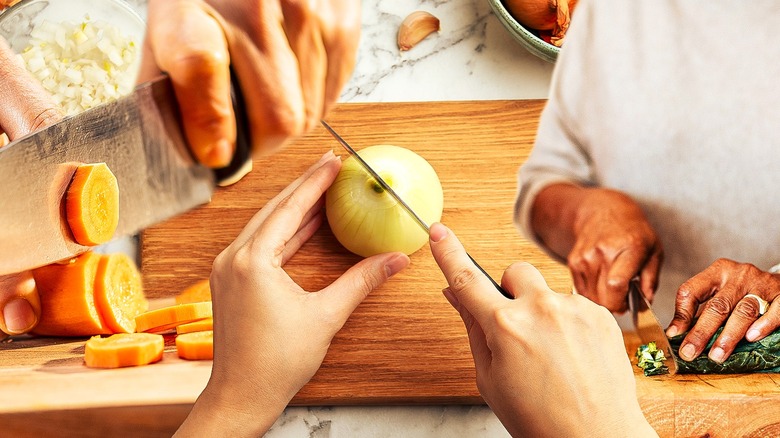Finishing a cutting board is an essential skill for any kitchen professional. It does not only enhance the visual appeal of the board but also contributes to its longevity and performance. But how to finish cutting board correctly? In this comprehensive guide, we will dive deep into the finishing techniques, benefits, and tips on maintaining a high-quality cutting board.
The process of finishing a cutting board involves applying a protective layer that can keep the surface from absorbing moisture, bacteria, and stains. Many professionals wonder how to finish cutting board surfaces effectively to balance functionality with aesthetics. This article is tailored to meet the needs of kitchen experts like you!

Understanding the Importance of Finishing
The collision of knives and the constant exposure to food materials makes cutting boards prime candidates for wear and tear. Understanding the importance of finishing not only helps in prolonging the life of the board but also maintains its hygiene and aesthetic appeal. The right finish creates a barrier that makes it easier to clean and less prone to water damage.
Types of Finishing Oils
When experimenting with how to finish cutting board surfaces, it's crucial to know which types of oils are safe and effective. Here are a few popular choices:
- Mineral Oil: Easily obtainable and food-safe, mineral oil penetrates well and protects the cutting board from water.
- Beeswax: Often combined with mineral oil, beeswax provides a protective film and helps reduce friction.
- Wood Oil: Products specifically made for wooden surfaces can enhance appearance and protection.
Step-by-Step Process: How to Finish Cutting Board
Follow this structured method to ensure your cutting board receives the treatment it deserves:
- Clean the Board: Thoroughly wash your cutting board with hot, soapy water. Rinse and let it dry completely.
- Sand the Surface: Use fine-grit sandpaper to smoothen any rough spots. Sand evenly and in the direction of the grain.
- Apply the Finish: Pour a small amount of your chosen oil onto the board. Use a clean cloth to spread it evenly, rubbing it in with circular motions.
- Let It Absorb: Allow the oil to soak into the wood for a few hours or overnight. Wipe off any excess oil with a clean dry cloth.
- Repeat Periodically: Depending on usage, repeat this process every few months to maintain the protective layer.
For more in-depth instructions on maintaining various types of cutting boards, check out cleaning wooden boards.
Maintaining Your Finished Cutting Board
Once youve finished your cutting board, maintaining it becomes critical in ensuring its longevity. Here are some vital maintenance tips:
- Regular Cleaning: Wash the board with mild soap and warm water. Avoid soaking it in water.
- Disinfecting: Consider using a diluted vinegar solution to disinfect the surface.
- Storing: Store your cutting board in a dry place; excessive moisture can lead to warping.
If you're new to your cutting board care journey, refer to cutting board hygiene for additional safety tips.
Choosing the Right Cutting Board Material
Deciding how to finish cutting board also depends on the material youre working with. Different materials react differently with finishes. Heres a brief rundown of popular materials:
- Wooden Boards: Typically require oils, not all woods are suitable for cutting surfaces.
- Plastic Boards: Easier to maintain but may need other kinds of treatments.
- Bamboo Boards: Enjoy similar care as hardwood boards but can be more delicate.
If you want to learn about the differences between wood and plastic cutting boards, check this insightful article.
Common Mistakes When Finishing Cutting Boards
Even knowledgeable kitchen professionals can make mistakes! Here are some common pitfalls to avoid:
- Over-sanding: While smoothing, excessive sanding can remove too much material.
- Ignoring Drying Times: Not letting the board dry completely before use can trap moisture.
- Using Non-Food-Safe Finishes: Avoid any oil or finishes with harmful chemicals.
For those facing mold issues due to improper cleaning methods, refer to dealing with mold.

Frequently Asked Questions
What is the best oil to finish a cutting board?
The most recommended oils are mineral oil and beeswax. Both are food-safe and effectively protect the wood.
How often should I finish my cutting board?
It is advisable to reapply the finish every one to three months, depending on your frequency of use.
Is it necessary to finish a plastic cutting board?
Plastic cutting boards generally do not need a finish, but they should be cleaned regularly to maintain hygiene.
As an Amazon Associate, I earn from qualifying purchases.


























